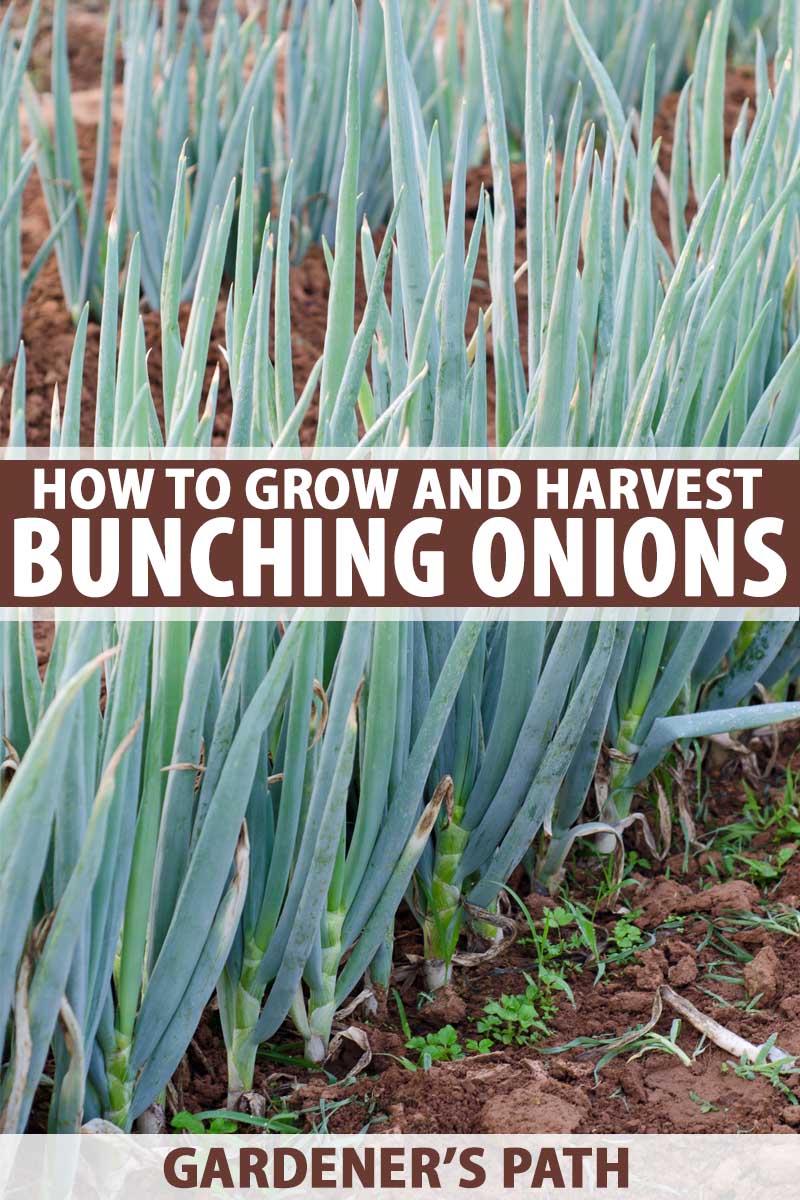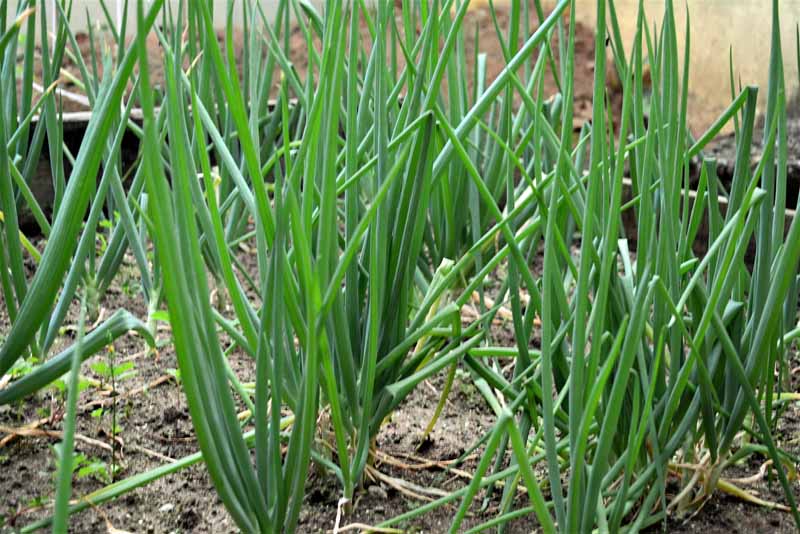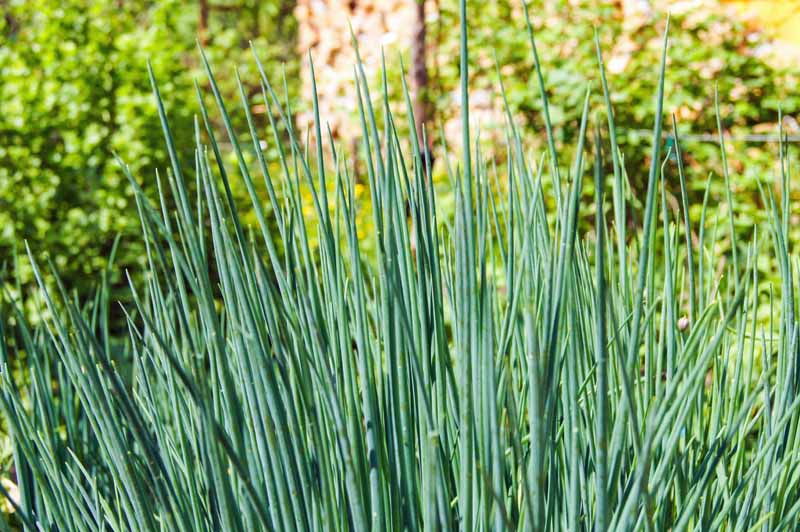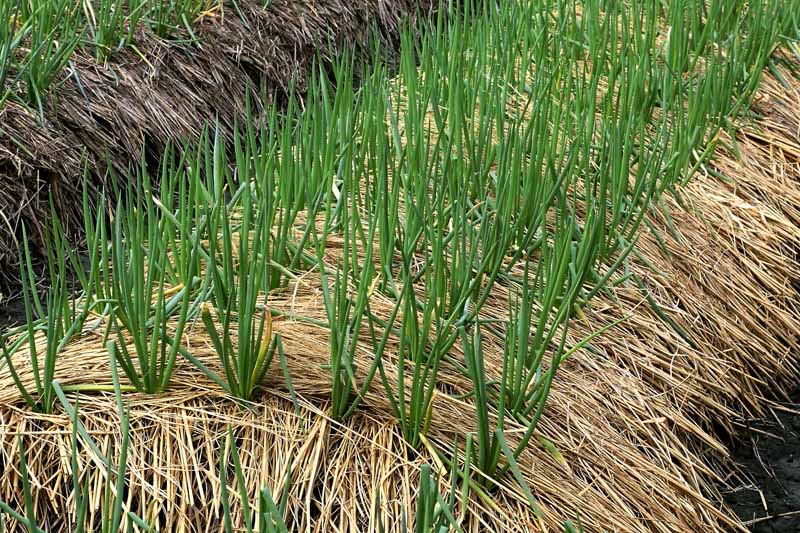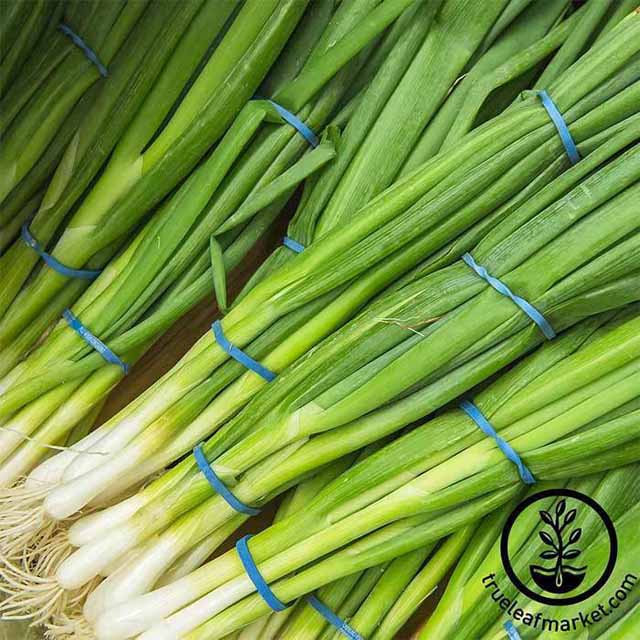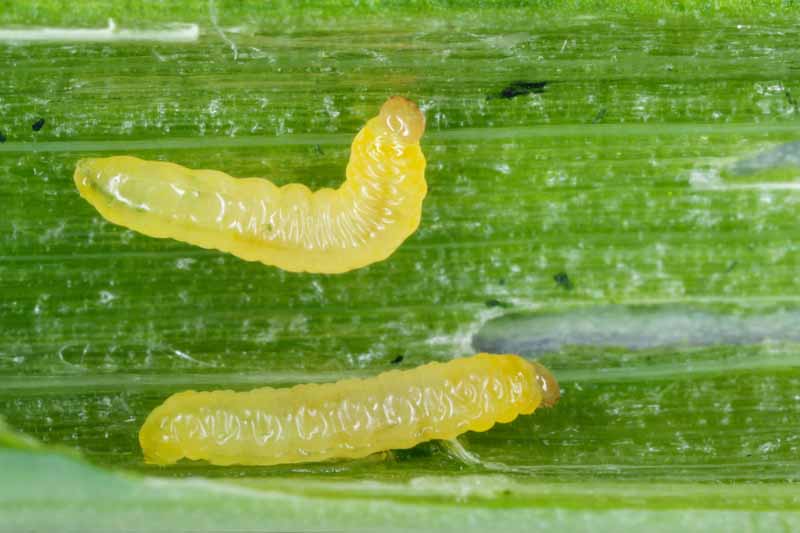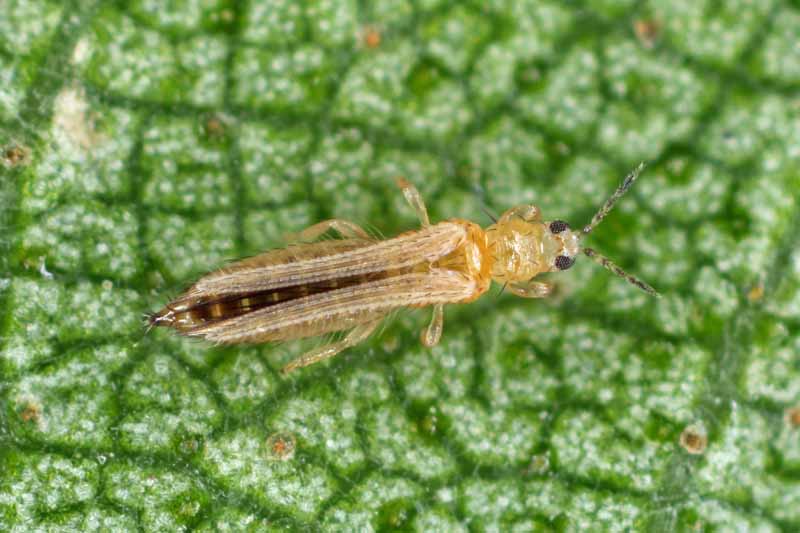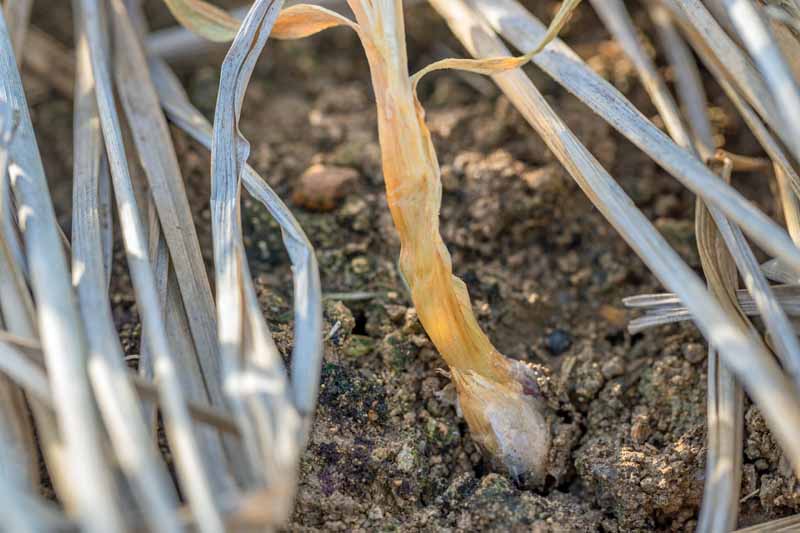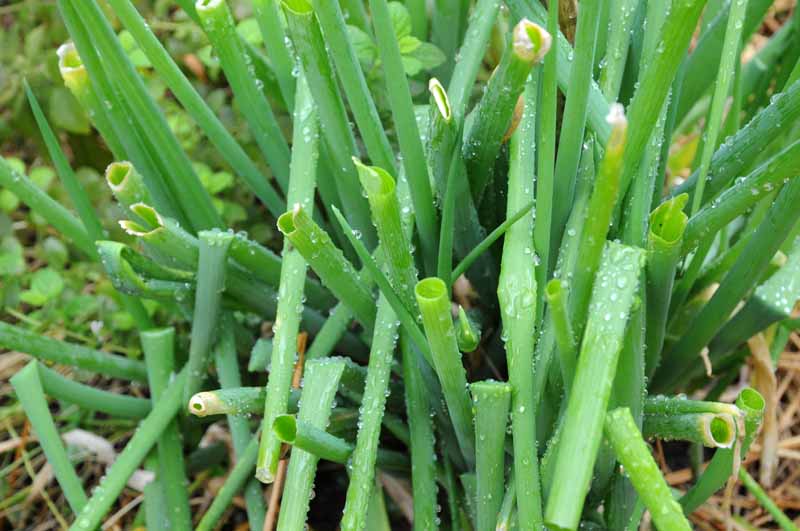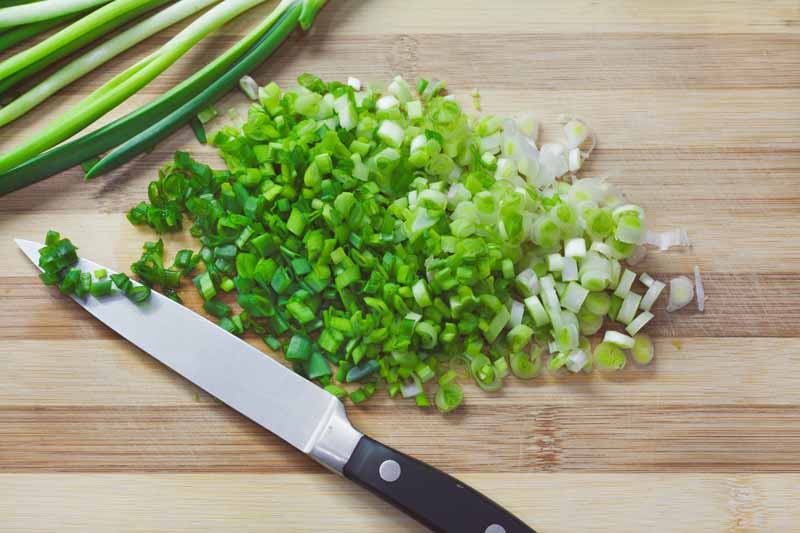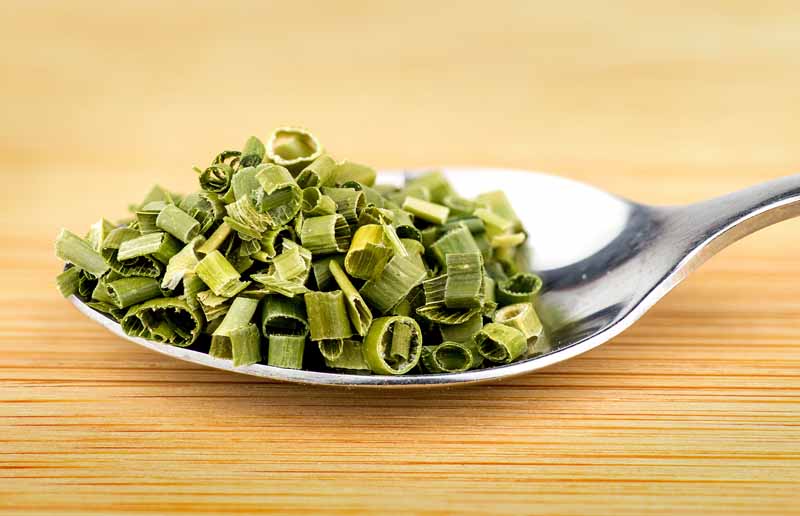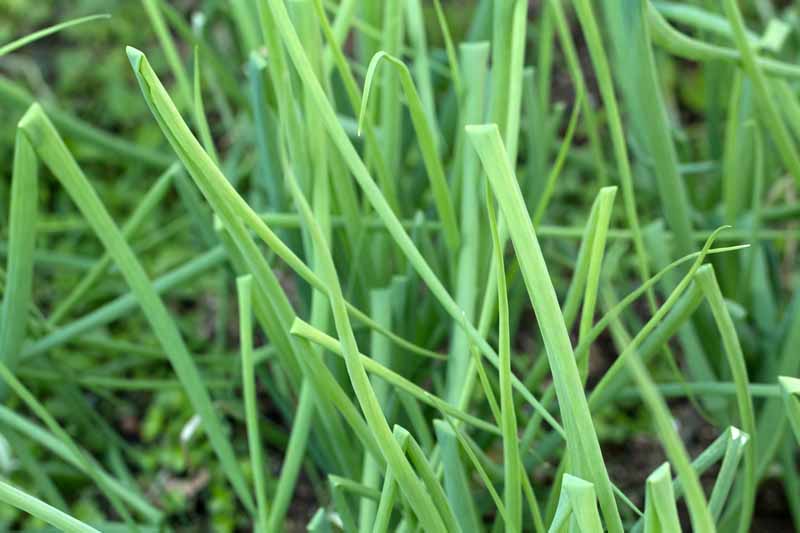Probably my all-time-favorite things to eat straight out of the garden are bunching onions! At the peak of the season, I’d estimate that eat a handful of the leafy tops each day during my garden walks, not to mention the bundles that I chop up and sprinkle in soups, stir fries, and sandwich fillings. We link to vendors to help you find relevant products. If you buy from one of our links, we may earn a commission. Here’s what’s to come in this article:
What Are Bunching Onions?
Also known as Welsh onions, green onions, Japanese bunching onions, spring onions, and scallions, these are perennial non-bulbing alliums that produce yummy green stems and tiny white roots, year after year!
They have thick, round, hollow stems that are bright green in color, and unique and lovely greenish-white flowers that are slow to develop and bloom through much of the summer. The leaves have a mild onion flavor and are edible raw or cooked. Larger varieties are similar to leeks, and smaller ones resemble chives. The flowers are edible, with a similarly sharp flavor, though they tend to be a bit dry.
These perennials are so fast and easy to grow that they are often utilized as annuals, harvested completely, and then reseeded in succession over the course of a season. Learn more about succession planting here.
Similar Species
Distinguishing between bunching onions and other allium varieties can be tricky. After all, pretty much any type of onion will produce edible greens. For instance, the common bulbing onion, A. cepa, can also produce green onions early in the season, and many scallions sold in US grocery stores are actually greens from early bulbing onions. Here are a few more similar species that produce edible greens: Though similar in taste to many of these relatives, A. fistulosum is a true perennial bunching onion that does not form a bulb, and its green foliage tends to be superior in flavor!
Cultivation and History
Though often referred to as Welsh onions, bunching onions did not originate in Wales, nor do they have a particular connection to Welsh culinary tradition. In this case, “Welsh” refers to an Old English form of the word, which was once taken to mean “foreign.”
In fact, this long-cultivated crop is native to China. Its use by humans dates back to at least 200 BC. It likely reached Japan by 500 AD and spread from there across Asia and Europe, eventually landing in North America. In addition to being a tasty inclusion in all manner of cuisine, it also has many uses in Chinese medicine. It has been used to help improve metabolism, prevent cardiovascular disorders, and fight colds and upper respiratory infections. A poultice made from scallions is said by herbalists to even be helpful for treating infections or draining sores. A poultice is a moist lump of plant matter that is placed on the skin to treat wounds or skin ailments. It can be wrapped in cloth or applied directly to the skin.
It is also conveniently useful to help protect gardens! The juice can be used as a moth or aphid repellent, and the whole plant is thought to repel certain types of insects including termites, as well as moles. Not a bad deal! (Please let us know if you have any success trying this in your own garden…).
Propagation
This hardy plant can be grown easily from seed or transplants, or by division. Find a spot in full sun or partial shade, with well-draining soil. For best results, incorporate plenty of organic material such as compost or aged manure prior to planting.
From Seed
Sow seeds in early spring for summer harvests, or in late summer to mature in the fall or spring.
Plant a quarter to half an inch deep about quarter of an inch apart in rows two to three inches wide, or broadcast seeds. Once seedlings are well established, thin to an inch apart.
From Seedlings/Transplanting
Start seeds indoors about five to six weeks before the last frost date for your area. Maintain an average temperature of 59 to 68°F, and keep the soil moist until germination, which will take between seven and 10 days on average. Once plants are three or four inches tall and all risk of frost has passed, transplant to the garden in rows, leaving a few inches of space between each. Water dry soil gently before planting. You can dip the bottom of roots lightly in water or liquid fertilizer before setting in the soil.
Division
Once established, plants can be divided easily to spread throughout your garden, or to share with friends and neighbors! Division can be done at any time of year, but spring is best. To divide plants, just dig up a clump, carefully split the root ends into several sections, and replant.
How to Grow
Bunching onions are very resilient. They will grow in almost any soil conditions and can even tolerate drought. That being said, providing nutrient-rich soil in full sun with plenty of water will certainly help to produce a superior crop.
Plants will benefit from regular watering, as well as the addition of liquid feed such as comfrey tea or fish fertilizer every few weeks. To make a homemade comfrey tea fertilizer, cut a bunch of comfrey leaves and place them in a five-gallon bucket of water. Wait a couple of days, strain, and this nutrient-rich “tea” is ready to be used on your plants. Be warned, it does have quite a strong smell! You can find complete brewing instructions here. It is also important to keep the area around your plants free of weeds. Surrounding them with a thick layer of mulch is an ideal way to both keep weeds down and keep the soil moist.
Growing Tips
In preparation for winter, apply a thick layer of mulch over plants in the fall. This will protect plants through the cold weather and help to stimulate an earlier crop. Remove the mulch in spring, once the soil has warmed up.
Try planting in succession every three to four weeks for a continual supply! You could also try hilling plants with soil as they grow, mounding it a couple inches higher with each addition. This will force the leaves to grow higher up the plant, resulting in long, blanched stalks and much longer edible greens.
Pests
We’ll begin with the most common insect pests that may plague your crop, with identification info as well as ways to combat them and avoid infestation.
Evergreen
This non-bulbing onion is mild and delicious as a fresh garnish for salads or cooked dishes.
‘Evergreen’ Slow to go to seed, expect 65 to 120 days to maturity. Seeds are available from True Leaf Market.
Heshiko
Try this hardy Japanese variety that grows 12 to 14 inches high and is great for overwintering.
‘Heshiko’ This variety matures in 60 to 120 days and is suitable for all growing zones. You can purchase seeds at Eden Brothers Nursery.
Tokyo Long White
This is another Japanese heirloom type that grows well in the US and is great for use in cooked dishes.
‘Tokyo Long White’ This one matures more quickly than other varieties – you can expect 75 to 95 days to harvest. Seeds are available at Eden Brothers.
Managing Pests and Disease
While tasty to you and me, bunching onions are typically not all that tempting to pests, and don’t often experience problems. In fact, planting alliums around the edges of garden beds is often done as a precaution to ward off unwanted insects and herbivores like rabbits. Nonetheless, there are a few pests and diseases that can occasionally strike.
Allium Leaf Miners
These small flies lay their eggs inside the leaves of allium-family plants, and can eat their way down to the roots, creating little white spots along the tips of the leaves. The wounds left by the mines can become rotted by fungi or bacteria, which can ultimately destroy the plant. Once the miners have burrowed into the crop, there’s little you can do.
This is a relatively new pest in the US that is still being researched, with the first infestation in the Western Hemisphere being confirmed in 2015 in Lancaster County, Pennsylvania. The best method to deal with these insects prevention, by timing crops to avoid infestation as part of an integrated pest management program. You can also use row covers to prevent flies from laying eggs on plants. Read more about identifying and controlling allium leaf miners here.
Thrips
These tiny insects create blotchy streaks on the tops of plants, causing deformity in the leaves. Hose off leaves with a strong jet of water in the late morning to remove insects. You can also coat each leaf with a homemade insecticidal soap. Read more about managing thrip infestations here.
Disease
Several types of disease may affect your crop, particularly if plants are weakened and made more susceptible by insect infestation or changes in the weather.
White Rot
This soil-borne fungus can affect all plants in the allium family. The disease causes white mold to form at the base of the roots, sometimes ruining plants.
Practice crop rotation to reduce disease spread. But keep in mind that preventing recurrence may not always be possible, as white rot can live in soil for anywhere from 8 to 20 years. Be sure to avoid using starts or seeds that have been infected.
Downy Mildew
Mildew can leave fuzzy growths on leaves, causing them to turn yellow or brown and collapse. Avoid planting infected sets, rotate crops regularly to areas that have not had other allium species grown in them in the last few years, and plant in well-draining soil.
Botrytis Leaf Blight
This is a foliar disease that causes small white spots on leaves and causes tips to wilt and die back. Eventually, this can cause all of the foliage to die. Wet weather can cause spores to germinate and spread rapidly. Destroy any infected plants and reduce the risk of spreading by rotating to areas where no other allium species have been grown for the past few years.
Harvesting
Plants can be harvested in two ways: you can pull entire plants and eat them like green onions, or you can snip off leaves as needed throughout the growing season, more like chives. Leaves will grow back quickly and can be cut down several times throughout the season.
I prefer to stick mainly with the snipping method, pulling up only a few plants here and there once a patch is well established. This way, I can ensure that this hardy perennial continues to thrive and produce each year without any extra work for me! Harvesting can begin any time after plants have reached four to six inches high. The larger they get, the stronger the flavor will be! If pulling up entire plants, you may want to wait four to five months from seeding to harvest, until they reach full maturity. In warm climates, this plant can be harvested year-round. In the first year, do not begin harvesting until midsummer, and be careful not to over harvest, so that young plants will have the opportunity to develop strong roots. You should also remove flower heads when they form, unless you are planning to save seeds or enjoy the flowers in your cooking.
Preserving
Bunching onions can be stored for up to 10 days in the crisper drawer of your refrigerator. They can also be frozen easily, or dried for longer preservation.
Freezing
Wash greens thoroughly and lay them out to dry. Next, chop them up into little rings of whatever thickness you prefer.
That is pretty much it! There’s no need to blanch prior to freezing, simply pack them into freezer containers, bags, or glass jars. Whenever you need a few for cooking, just grab a handful and throw it right into your meal.
Drying
This is perhaps my favorite preservation method for this plant. Since the greens tend to dry fairly quickly, are able to be stored for years, and take up very little shelf space, drying is a prudent way to preserve an abundant crop.
Begin by washing and chopping the greens, and then allow them to air dry. Use a dehydrator or place them in the oven at the lowest heat setting, until no moisture remains. For more on dehydrating the garden’s bounty, read all about it on our sister site, Foodal. I like to put them in the oven on the “warm and hold” setting, but if this isn’t a feature that your oven has, just use the lowest temperature available. They dry quickly, so check them often!
Recipes and Cooking Ideas
Delicious on their own or as an enhancement to a main course, these sharp green leaves make a perfect addition to any meal. On a warm day, try dipping crunchy veggies in a cooling scallion dip, or warm up on a chilly evening with a sweet and zesty bowl of green onion soup. Use them to add a delightful crunchy spice to salads and sandwiches, or to flavor broths, enhance stir fries, and spruce up your dinner with a lively garnish. Foodal has a useful guide on ways to prepare and use green onions. Try going fancy with some mouth-watering green onion frittatas. This fun recipe from Foodal combines fresh scallions, peas, and feta to make mini frittatas in muffin tins.
Quick Reference Growing Chart
Grow Yourself a Bundle
Bunching onions, Welsh onions, scallions – whatever you want to call them, there really isn’t a downside to cultivating a bundle of these hardy alliums in your garden.
They are so easy to grow and care for, and if you do it right, you can continue to obtain a harvest from the same plants year after year. If you found this guide valuable, you’ll also find some excellent info on growing other types of alliums here, both edible and ornamental:
How to Grow and Care for Drumstick Allium Flowers How to Plant and Grow Garlic in Your Veggie Patch Flowering Alliums Transform Your Yard for Weeks
© Ask the Experts, LLC. ALL RIGHTS RESERVED. See our TOS for more details. Uncredited photos: Shutterstock.

